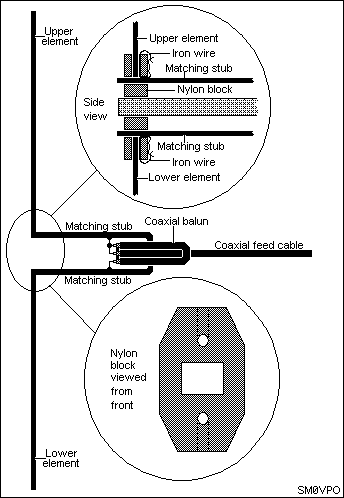

It is not particularly difficult to make a VHF antenna with omni-directional properties as well as having a 6dB gain*. A "Slim-Jim" antenna is quite popular but only realises about 1.7dB of gain*. I had a problem with my packet radio station and decided that antenna gain was the solution. So now I have a 6dB gain VHF colinear. I also managed to get another 6dB or so out of my old tired-out IC260A VHF receiver with a bit of dexterous tuning.
(* - referenced to a simple 1/4-wave whip antenna)

This drawing shows the basic construction. There is nothing new about the technology, mounting a half-wave above another is quite common. Both Marconi and Franklin developed similar techniques, but Marconi was more keen on capacitive coupling between the antenna elements whereas Franklin proposed 1/4-wave stubs in a variety of simple and complex forms (Antenna Engineering Handbook by Jasic). My antenna follows the Franklin approach, but using 4mm hard drawn aluminium rods, supported by bits cut out of a nylon chopping board "liberated" from the kitchen (when the wife is not there - of course). Each element and the stub are all a calculated 1/2-wave in length (1030mm) but the stub is to be about 2" (5cm) longer. The stub is folded to form two parallel bars, 5cm apart joined together at one end. The two radiating elements are left as single straight elements. These three formed elements are supported by two cut and shaped blocks of nylon.


I have not shown the dimensions of the cut blocks but the inserts in the first picture show you exactly how they are formed. It all depends upon what size wooden mounting boom you have. It could of course be metal, but I had a bit of wood sitting doing nothing on the balcony. The only important bit is that the stub should be 1/4-wave in length, not counting the shorted (folded) end.
Insert the center spacer first then just push-fit everything together (using a little brute force). The vertical / horizontal holes in the end-block must have an electrical connection between the stub and driven elements. I used a bit of ferrous (it will stick to a magnet) wire from a component lead, threaded through the holes so that there was a good contact between the two. Copper is well separated from aluminium in the atomic scales so, given time, you will find corrosion between anodic and cathodic metals such as copper. In case you did not know it, most of your resistors and capacitors use ferrous wires, just take a magnet and test them. The nylon chopping block is more than adequate to support the elements, even in high winds.


Connections are made 15cm (6") from the closed end of the stub. The stub is fed with a 50-200 ohm coaxial unbalanced to balanced balun. Using RG58 or URM76 the length of the loop forming the balun needs to be 0.33 x wavelength. A 1/2 wavelength radiating element for 145 MHz is 1030mm and the length of the coaxial balun should be about 690mm, folded to form a 345mm loop. You could, of course, simply roll it up!
I have recently seen several articles published using this type of antenna made from copper pipe, but I think that my method is far easier to make as well as costing virtually nothing in both money and effort (if the wife does not catch you). VSWR? I never even adjusted mine; it didn't need it!
After all this I still could not get into SL0ZS on the packet radio, but the problem was because of the packet BBS and not my equipment. But at least my signals are at least stronger than before and I can now access several local VHF repeaters, men jag måste träna på svenska innan jag försöker.
